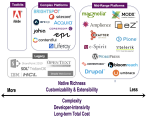IBM, Microsoft, and the patent mess - how to protect yourself
Last week, the U.S. Patent & Trademark Office made public a new Microsoft patent application titled "Content Management System and External Data Storage System Data Synchronization." (Interestingly, it specifically mentions SharePoint by name.)
Microsoft is basically trying to patent the idea of letting data synchronization be triggered by administrator actions in a content management system. According to the Abstract of the application: "In one example, an administrator creates or modifies an event at the content management system, and if the event is coordinated with the external data storage system, the content management system is synchronized with the external data storage system."
This comes on the heels of an IBM patent application (dated 8 October 2008) called "Promoting Content from One Content Management System to Another Content Management System." IBM's claims are not exactly the same as those made in Microsoft's application, but the point is, it's amazing anyone would try to patent basic content handling patterns (something we've commented on before). And yet, year after year, you see big players like IBM and Microsoft (the two top patent-accumulators in the U.S.) filing patent application after overlapping patent application, often involving very straightforward-seeming sorts of things, in an arms race that never ends.
With so much of the technology landscape papered-over by patents, you'd think Microsoft, IBM, and others would be in court a lot more than they are. But that's not the way the game's played. Patents (at the level of giant public companies) are defensive weapons, tools for maintaining the balance of power. If you're Microsoft, you can look a competitor in the eye, smile menacingly, and say "I won't fire the first shot if you won't."
Patent portfolios are important leverage in many bargaining situations. A not-so-well-known fact is that Novell's 2006 Linux deal with Microsoft (worth $348 million to Novell) actually had to do, largely, with patent indemnification. Terms of the 2006 deal included the two companies holding each other (and their respective customer bases) harmless against using each other's patented technology. It wasn't a technology swap per se; it was more like: "We know you're already violating some of our patents; that's okay this time. We forgive you, if you forgive us."
The reality is that every big tech company has patents that are being violated every day by competitors. (HP almost certainly has patents that are being violated by Sun, Sun is sure to have patents that are being violated by IBM, and on and on.) No company has the time or money to litigate it all. Therefore you pick your battles carefully. If you're IBM, why waste capital suing Microsoft over Patent A if they're going to sue you right back over Patent B? You sue only when there's a genuine, urgent business need to do so. The rest of the time it's a nuclear standoff.
If you're a little guy, though, there's no way you're going to enough patents to play the M.A.D. (mutual assured destruction) game, and you can count on Microsoft litigating you out of the market if you try to violate their intellectual property in any way.
The true pawn in this situation, alas, is you the customer. Unfortunately, if your vendor has not indemnified you against third-party patent actions arising from unauthorized use (by your vendor) of patented technology in its products, you could find yourself in a poor legal posture if war breaks out between patent-holders. You might have to cease using the software in question, or join a lawsuit, or face any number of other unexpected (and costly) emergency actions. If you haven't checked your current license agreements for patent indemnification terms, you just might want to do so now.
And if you're in the middle of a vendor selection process or about to sign a contract, be sure patent indemnification is part of the fine print. All-out nuclear war between patent holders is rare. But you don't want to be caught out in the cold when nuclear winter arrives.








